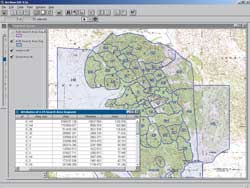Persistence and Technology Save Hiker
By Russ Johnson, Esri Public Safety Solutions Manager
Editor's note: Each year more than a million hikers, bicyclists, rock climbers, and others visit Joshua Tree National Park in Southern California. Located 140 miles east of Los Angeles, the park covers 800,000 acres and spans three California ecosystems. It boasts some of the most impressive geologic displays in the country as well as archaeological sites and unique plant and animal communities.
Despite a network of roads and well-marked trails, each year six to eight visitors are lost in its vastness. In this harsh and unforgiving desert environment, lack of water or inadequate clothing can prove fatal in a matter of days. When a 60-year-old man hiking in the park was reported missing, park service personnel launched a massive search that was supported by surrounding agencies. To avoid duplication of effort and save time, searches in the air and on the ground, both on horseback and foot, were coordinated using maps produced with GIS.
Tom Patterson, the park's fire management officer, has helped develop techniques for using GPS with GIS, particularly mobile GIS, for mapping emergency response. Patterson and two park staff members, Steve Elenburg and Shad Murphy, worked tirelessly tracking search efforts and producing maps that helped professional staff and volunteers work efficiently.
 |
| Tom Patterson, the park's fire management officer, inputted data from the teams as they completed their assignments so that he could generate maps that allowed incident managers to instantly tell which segments were searched adequately and which needed to be revisited the next day. |
The search for a 60-year-old man in Joshua Tree National Park is one of the first search and rescue (SAR) incidents in which GIS and GPS were used effectively from the initial response phase to the discovery of the subject. On April 21, 2003, Marvin Matsumoto and his 16-year-old son, Mark, were returning from a hike when they decided to split up. Their plan was to travel in opposite directions along a one-mile loop trail near Barker Dam and meet in the middle of the dam.
Barker Dam is located in a rugged section of the park known as the Wonderland of Rocks. This 20-square-mile maze of house trailer sized boulders can easily disorient even an experienced hiker who is unfamiliar with the terrain. As a consequence, the Park Service has conducted numerous SAR operations in this area. Unfortunately, some operations have resulted in body recoveries.
This was Matsumoto's first visit to the park. He had no food, water, flashlight, or other survival provisions with him and was wearing only blue jeans, a white t-shirt, smooth-soled deck shoes, and a ball cap. A cold front had moved into the area sending overnight temperatures plummeting into the upper 30s accompanied by winds of more than 40 mph. The SAR operation for Matsumoto was immediately deemed a high priority. During the next five days, the most extensive search in Joshua Tree National Park in almost 20 years was carried out.
Just prior to the Matsumoto search, Joshua Tree National Park hosted the GPS for the Incident Command System training course. Held April 7–11, the course drew 35 participants from Maine, Georgia, Colorado, Montana, Oregon, Wisconsin, Arizona, Idaho, Texas, New Mexico, and all over California who came to learn new and innovative ways to use GPS and GIS to map wildland fires.
The aerial mapping exercise, a highlight of the course, teaches students the intricacies of digital mapping from a helicopter. As part of the exercise, students learn how to convert GPS track files to a shapefile using the DNR Garmin ArcView extension developed by the Minnesota Department of Natural Resources. The course not only teaches students GPS navigational skills but also how to collect accurate data that conforms to national mapping standards and use GIS to display data.
GIS played an important role during the search. Captain Steve Elenburg and Engine Operator Shad Murphy, two firefighters from Joshua Tree who had just completed this course, put their new skills to good use in the Matsumoto search. They flew numerous daily reconnaissance flights and quickly converted this data to shapefiles.
 |
| Matsumoto was found on April 25, 2003, at 2:20 p.m. in a location approximately 2.5 miles north of where he was last seen. He had fallen into a space between boulders and was not visible from the air. |
Printing larger D-size maps of the search progress required using the plotter located 28 miles away in the GIS lab at park headquarters.
The plotter at park headquarters operated almost nonstop, printing out the topographic maps of the primary and outlying search areas. Field team members appreciated the full-size color maps with Universal Transverse Mercator (UTM) grids that were far more useful than the reduced fourth-generation black and white copies with washed out contours that they usually received.
On the fourth day of the search, a GIS trailer and GIS technical specialist were ordered from the California Governor's Office of Emergency Services to eliminate travel time. This was done in anticipation that the amount of resources available during the weekend would be doubled. Search resources included helicopters-some equipped with infrared detection sensors, fixed wing aircraft, search dogs, mounted posse members, and trackers. Due to the difficult terrain, many teams were also equipped to handle technical, high-angle evacuations.
Continued on page 2
|